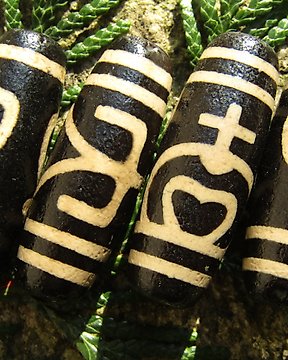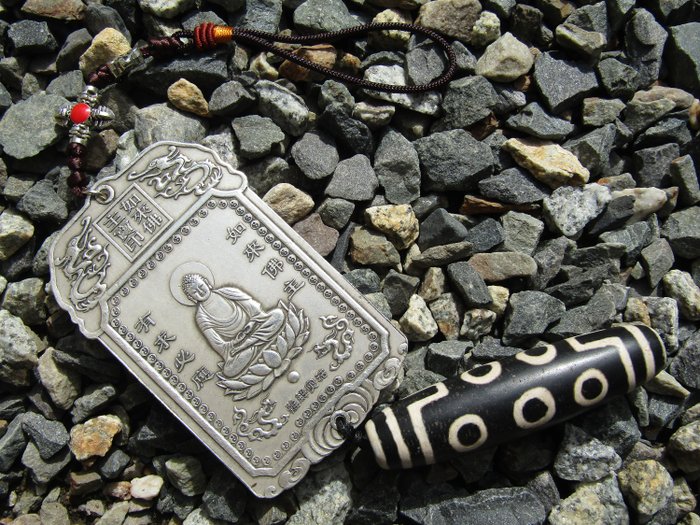
4顆象牙天珠「僧侶加持」(39毫米)- 繁榮/靈性組合+書法- 44 g
編號 81886363

編號 81886363

This Talisman is made of Tibetan Silver (copper/tin/silver alloy).
-------------------------------------------------------------------
NEW CEREMONY 03/2024:
https://www.youtube.com/watch?v=8avOOWgK3L0
-------------------------------------------------------------------
>>> All the DZI I sell receive a Purification and Awakening Ceremony by my friend and Mongolian Monk Jagdag. This Ritual is inspired by chinese "KAIGUANG" (開光). Kaiguang is the Chinese term for consecration of a statue of a deity. In Chinese, the literal meaning of Kaiguang is "opening of light". While it is often performed in the Buddhist and Taoist faiths. It is believed that if a statue dont go through KAIGUANG, it cannot be worshiped or used for performance, as the eyes are still "closed".
-CEREMONY VIDEO (youtube): https://youtu.be/nyH3jYXSar4 (2022)
-CEREMONY VIDEO (1st half-30mn): https://www.youtube.com/watch?v=VfuRI8ihEIU&t=341s
-------------------------------------------------------------------
----------DZI 10 EYES----------
>>> Dzi bead 10 eyes dissolves and removes all obstacles that arise in human life and harmonizes any kind of activity. She is called the “cleansing Dzi”, as she clears everything that prevents to achieve the goal. She helps to cope with obstacles at work and in business, where this Dzi helps a successful career and business accomplishments.
>>> A 10-eye Dzi bead also helps to establish harmonious relationships in the family and with other people. She removes the negative in these relations and translates it into a positive channel. Thus, this 10-eyed Dzi bead removes those obstacles that interfere with good and constructive communication with any people in society. The owner of such a talisman receives honor and respect among colleagues and friends.
-----Help cleanse Karma-----
>>> The 10-eye Dzi bead is unique in that it helps in working with human karma. If someone suffers from a series of failures and bad luck, if the black streak of life follows the black one again, then get and wear this 10-eyed Dzi bead. It helps to cleanse past and present sins, remove the negative that has accumulated in past human acts and turn the tide with negative events in life in a positive way.
>>> For those people who work on themselves and engage in self-improvement, this 10-eyed Dzi will help to more easily clear the load of karmic problems. Negative moments of the past create the so-called “negative karma”. In psychotherapeutic sessions, meditations, and other spiritual practices, these karmic problems are more easily and quickly dealt with if you have such a Dzi bead.
-----Practical use-----
>>> In practice, the Tibetan bead Dzi 10 eyes is used in cases where a person feels that something is stopping him in life from achieving his goal. This bead clears everything that prevents success in life. Its action is manifested in all areas of life.
>>> Wearing it helps to remove obstacles and achieve better results at work, in business and in any type of activity. It helps to resolve quarrels and harmonize relationships in the family, gain success in society and live a joyful and happy life.
----------TATHAGATA: “Thus-Gone, Thus Come”----------
>>>The Buddha referred to himself as "the Tathāgata." Are you familiar with the many and varied meanings of this epithet?
Tathāgata: What’s in a Name?
Tathāgata is a Pali and Sanskrit term that is the first of ten epithets for the Buddha.
The ancient Sanskrit thesaurus, the Nāmaliṅgānuśāsanam or Amarakośa Tib. འཆི་མེད་མཛོད་, chi med mdzod, Immortal Treasure) lists a number of epithets or titles for the Buddha:
>>>Omniscient One, Gone to Bliss (Skt. Sugata), Awakened One, King of Dharma, Thus Gone One (Skt. Tathāgata), Always Good, Blessed Lord (Skt. Bhagavan), Victor over Māra, Victor of the World, Victorious One, Possessor of Six Super-Knowledges, Possessor of Ten Strengths, Speaker of Non-Duality, Remover of Obstacles,King of Sages, Full of Glory, Teacher, The Sage, Sage of the Śākyas, Lion of the Śākyas, Accomplisher of All Aims, Son of Śuddhodana, Gautama, Kinsman of the Sun, Son of Māyādevī.[1]
>>>The Buddha frequently referred to himself or described himself as “the Tathāgata” in Pali canonical texts instead of saying “I” or “me”. When he did this, he underlined a distinction marked by his awakening. In the Tibetan language, we translate the term as de bzhin gshegs pa. (phonetic dé zhin shek pa).
>>>Scholars debate the precise translation of this title because it is a compound word that could be broken up in two ways. In English, acknowledging that ambiguity, we translate it as “The Thus Come” or “The Thus Gone”.
-----Tathāgata: Tibetan Explanation of Etymology-----
Tridé Songtsen (ཁྲི་ལྡེ་སྲོང་བཙན), better known as Sadnalegs reigned in Tibet in the early 9th century. During his reign, a Tibetan lexicon was compiled entitled the sGra sbyor bam-po gnyis-pa, or the ‘Word-Combination‘. In this work, Tibetan scholars explain the etymology in this way:
>>>As for the word tathāgata, tathā means “thus” (Wylie de bzhin ), and gata means either “come” (Wylie gshegs pa), “departed,” “having understood” or “explained.” The general meaning of the word is connected to how the previous Buddhas came and went, but also how they understood the suchness (Wylie de bzhin nyid (phonetic dé zhin nyi)= Skt. tathatā) of the essence of all moments of existence just as it is, and explained that. However, we fix the well-known previous translation of “Thus Come” (de bzhin gshegs pa).
Titles of the Budddha
The Mahāprajñāpāramitōpadeśa (Mahāprajñāpāramitā-śāstra) attributed to Arya Nāgārjuna includes a chapter explaining the titles of the Buddha. In that chapter, we learn that
-1) He preaches the natures of the Dharmas (dharmalakṣaṇa) in the way (tathā) that he has understood (gata) them.
-2) In the way that the previous Buddhas have gone by the path of safety (yogakṣema-mārga), thus (tathā) the actual Buddha is going (gata) and will not go on to new existences (punarbhāva).
-----Ten Powers of a Tathāgata (dasa tathāgatabalāni)-----
Buddhas have also, of course, achieved the state of an arhat or “foe destroyer”, as have many of their disciples. In addition to that realization, a tathāgata also is foremost because a Buddha discovers and then teaches the path. Moreover, a tathāgata demonstrates ten powers.
These are:
Power over life (Tib. ཚེ་ལ་དབང་བ་, tsé la wangwa)
Power over mind (Tib. སེམས་ལ་དབང་བ་, sem la wangwa )
Power over material things (Tib. ཡོ་བྱད་ལ་དབང་བ་, yojé la wangwa)
Power over action (Tib. ལས་ལ་དབང་བ་, lé la wangwa)
Power over birth (Tib. སྐྱེ་བ་ལ་དབང་བ་, kyewa la wangwa )
Power over aspirations (Tib. མོས་པ་ལ་དབང་བ་, möpa la wangwa)
Power over prayer (Tib.་སྨོན་ལམ་ལ་དབང་བ་, mönlam la wangwa)
Power over miracles (Tib. རྫུ་འཕྲུལ་ལ་དབང་བ་, dzutrul la wangwa)
Power over wisdom (Tib. ཡེ་ཤེས་ལ་དབང་བ་, yeshe la wangwa)
Power over Dharma (Tib. ཆོས་ལ་དབང་བ་, chö la wangwa)